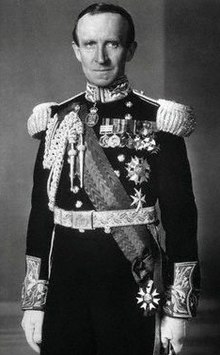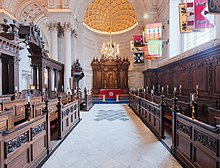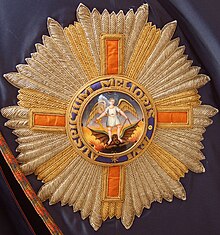Order of St Michael and St George

The Most Distinguished Order of Saint Michael and Saint George (Order of Saints Michael and George) is a British order that was established on April 28, 1818 by George, Prince of Wales (later King George IV). At that time Georg was Prince Regent for his father, Georg III. It is awarded in most cases to honor British nationals who held or have a high position in another state (e.g. diplomats ) or who have made significant contributions to the Commonwealth of Nations or to relations with foreign states. But there are also non-British members of the Order. The motto of the order is Auspicium melioris aevi (promise of a better time). His patron saints are the Archangel Michael and Saint George .
In the British honors system, the Order in the sixth position is to Garter , Order of the Thistle , the Order of Saint Patrick , Order of the Bath and Order of the Star of India . However, the Order of St. Patrick, an Irish medal, has not been awarded since 1934 because Ireland is no longer part of the United Kingdom. For similar reasons, the Order of the Star of India is no longer awarded.
Order classes
The order consists of three classes:
- Knight Grand Cross or Dame Grand Cross (GCMG)
- Knight Commander (KCMG) or Dame Commander (DCMG)
- Companion (CMG)
history

The order was founded on the occasion of the British Protectorate over the Ionian Islands , which received their own constitution in 1817. The medal was intended to honor residents of the Ionian Islands and Malta, as well as other people who held positions of importance for the Crown in the Mediterranean .
In 1864 the protectorate was given up and the Ionian Islands became part of Greece . From 1868 onwards, the order was therefore bestowed on people who held a high and important position in the British colonies and as a reward for the service they rendered to the crown with a view to the Empire's foreign relations . The head office of the order is now a museum for Asian art.
composition
The British monarch occupies the highest position in the order. He alone appoints the other members of the order, usually after consultation with or on the proposal of the government. The second highest position is held by the Grand Master. This was formerly the Lord High Commissioner of the Ionian Islands. Today the Grand Master is chosen by the monarch. Currently Edward, 2nd Duke of Kent , is the Order's Grand Master.
Originally the order consisted of 15 Knights Grand Cross, 20 Knights Commanders and 25 Companions. These numbers have been increased several times. Today the limits are 125, 375 and 1750. Members of the royal family who received the medal are not counted; the same applies to foreigners who can be appointed honorary members.
The Order has six offices: Prelate, Chancellor, Secretary, Registrar, King of Arms ( Herald of Arms ) and Usher (Order servant). The King of Arms is not a member of the College of Arms . The Usher of the Order is referred to as the Gentleman Usher of the Blue Rod . Unlike the Gentlemen Usher of the Black Rod, he has no duties to the House of Lords .
Ceremonial clothing and regalia

The members of the Order wear their own ceremonial clothing on important occasions such as the coronation of British monarchs , which depends on the class:
- The cape is only worn by the Knights and Dames Grand Cross. It is made of blue satin with purple silk. The breast star (see right) is worn on the left. The coat is closed with two large tassels .
- The collar , also only worn by Knights and Dames Grand Cross, is made of gold. Its limbs consist alternately of crowned lions, Maltese crosses and the letters SM (Saint Michael) and SG (Saint George). In the center there are two winged lions, each holding a book and seven arrows.
Simpler insignia are used on less important occasions:
- The breast star is only worn by the Knights and Dames Grand Cross and by the Knights and Dames Commanders on the left chest. The star of the Knights and Dames Grand Cross consists of seven silver stripes with a gold stripe in between. The star of the Knight and Dame Commanders is slightly smaller and has no gold stripes. The red cross of St. George is on all the stars. In the middle is the motto of the order in golden capital letters on a dark blue round surface. Within this circle, Saint Michael is shown stepping on the devil.
- The medal is the only one worn by all members of the order. Knights and Dames Grand Cross wear it on a blue-purple-blue ribbon that is worn over the right shoulder to the left hip. Knight Commanders and male companions wear the badge on a ribbon around their necks. Dames commanders and female companions, on the other hand, wear it on a bow on the left shoulder. The medal itself is a seven-armed, white enameled Maltese cross. The obverse shows Saint Michael stepping on the devil; on the reverse you can see St. George killing a dragon from the back of a horse.
On certain days determined by the monarch, the so-called collar days, the members of the order can, if they take part in a ceremony, wear the collans over their military uniform or their civil evening clothes. The medal is attached to the collar when it is worn on a collar day or during important ceremonies.
All collans awarded since 1948 must be returned to the Central Chancery of the Orders of Knighthood upon the member's death . The other insignia can be kept.
chapel

The seat of the order was originally the St. Michael and St. George Palace in the island capital of the same name, Corfu , residence of the Lord High Commissioner of the Ionian Islands and seat of the Ionian Senate. Since 1906 the Chapel of the Order of St Michael and St George in the south ambulatory of St Paul's Cathedral in London has been the home of the Order. Religious celebrations for the entire order are held there every four years - most recently on July 17, 2008; the inclusion of new Knights and Dames Grand Cross takes place during such a celebration.
The Monarch and the Knights and Dames Grand Cross have their own choir stalls , above which the respective heraldic symbols of the knight are placed. His helmet is located here , surrounded by the helmet cover and surmounted by the crest . According to English coat of arms law , the coats of arms of women other than the monarch do not show helmets and crests; instead a diadem is used according to the lady's rank. The heraldic banner of the owner of the choir stalls hangs over the crest or diadem .
On the back of the choir stalls is a brass plate on which the name of the owner, his coat of arms and the date of admission to the order can be seen. If a knight dies, the flag, helmet, helmet cover and crest are removed; the plate, however, remains attached to the stalls. The choir stalls therefore show in a colorful way who has been Knight or Dame Grand Cross of the Order since 1906.
Hierarchy and privileges
Only citizens of the UK or Commonwealth of Nations can become regular members of the Order of St. Michael and St. George . Citizens of other countries can, however, be appointed honorary members. Knights and Dames Grand Cross have the letters GCMG as an addition to their name ; Knight Commanders and Dame Commanders use the letters KCMG and DCMG, respectively ; Companions use the letters CMG (so-called post-nominal ). These abbreviations are sometimes satirically interpreted as (in reverse order): Call me God, Kindly Call Me God, and God Calls Me God.
The members of the Order received a position in the protocol Aryan ranking in the UK ( Order of Precedence ), a ranking in which the registered persons are classified according to their nominal significance and plays an important role in ceremonial events. Wives of male members are also accepted there; also sons, daughters and daughters-in-law of Knights Grand Cross and Knight Commanders. In contrast, relatives of a female member are not included in the list.
By granting the top two levels of the Order of St. Michael and St. George, citizens of the United Kingdom and citizens of those Commonwealth countries that recognize the British monarch as their head of state ( Commonwealth Realms ) can be elevated to the nobility . The Knights Grand Cross and the Knight Commander is the occasion of the Order of Merit ( investiture ) by the monarch to the Knights ( Knight ) beaten and then use the title Sir before their first name. Dames Grand Cross and Dames Commander do not receive an accolade, but are also considered ennobled and bear the title of lady . Like the wives of all British Knights, the wives of the Knights Grand Cross and Knights Commander of the Order of St. Michael and St. George may have the addition Lady in front of their name; a comparable privilege does not exist for the husbands of the Dames Grand Cross and Dames Commander. Clergymen do not receive the knighthood , nor do the foreign members of the Order of St. Michael and St. George. Anyone who is not a citizen of the United Kingdom or the Commonwealth has honorary membership in the Order.
Knights and Dames Grand Cross are authorized to include a shield holder in their coat of arms . They are also allowed to include a circlet showing the order's motto and a picture of the collar in their coat of arms. Knights and Dames Commander and Companions may only show the bracelet in their coat of arms, but not the chain of the order.
literature
- William Arthur Shaw: The Knights of England. Volume 1, Sherratt and Hughes, London 1906, pp. Xxvii ff.
- Paul Ohm Hieronymussen: Handbook of European orders in colors . Universitas Verlag, Berlin 1966.
- Order of St. Michael and St. George. In: Heide N. Rohloff (Ed.): A royal millennium. Stagings of a monarchy , catalog and manual for the exhibition of the British Crown Jewels (in replica) [The British Heritage Exhibition], Hanover: Congress Centrum; Tourism Center, 1997, p. 81



